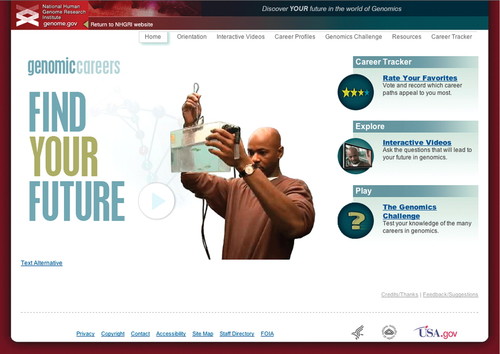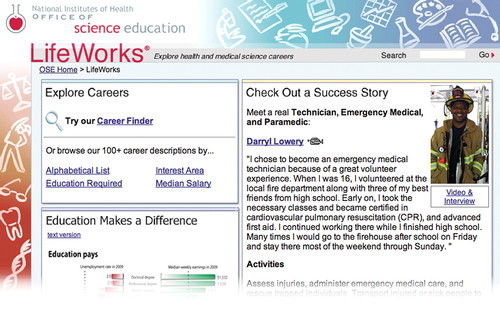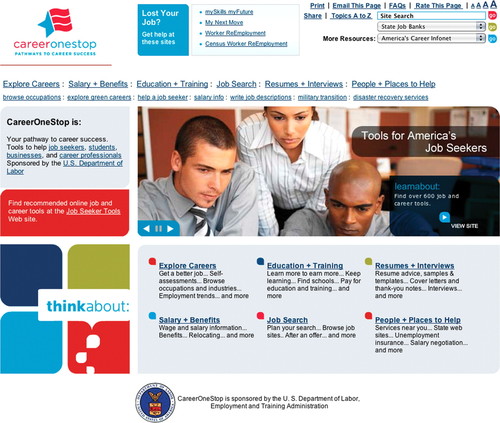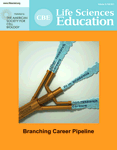Life Sciences Career Exploration
Is there a career that combines the environment, genetics, and engineering? What is a theriogenologist, and what education and skills does one need for this career? What careers can one enter with an associate's or a bachelor's degree? What careers have the best outlook in terms of projected new positions, and what salary ranges can one expect? This article provides an overview of free, online resources for career exploration, with a focus on life sciences careers. This review is intended to be of use to secondary and postsecondary students seeking information about careers in this field of science. Hopefully, teachers and faculty members advising students who are planning their career goals and majors will find this a helpful resource to share with students.
All of the online resources in this review include the following information for each career in their database: a description of the types of work involved, the level of education needed, the median income, the outlook for employment, and links to related careers and more information, such as professional society websites. Additional types of information and resources are noted in the reviews.
GENOMIC CAREERS
One of the newest resources is Genomic Careers (www.genome.gov/GenomicCareers/index.cfm; Figure 1), developed by the National Human Genome Research Institute at the National Institutes of Health (NIH), with input and feedback from student users. A short video (1:24 min) on the home page provides an introduction to genomics careers and the resources on the site. One of the most engaging ways to explore these careers is via the 52 videos. Most of the videos are interviews (0:49–14:30 min) with individuals representing various careers, conducted by three college-age interviewers. Five videos (2:45–20:47 min) provide a peek into working environments in industry, academia, and the government via tours. Videos also provide an introduction to DNA testing (7:56 min) and BLAST software (2:25 min). The longer videos offer an interactive option: a list of questions the user can select to view sections of the movies that provide answers. The videos have a closed-captioning option, and downloadable transcripts are available. The Career Profiles section of the site allows users to sort careers based on five areas of interest, nine types of careers, and median income. The results provide a one-sentence description of each career, education level needed, and median income, with a link to more detailed information. Figure 1. Genomic Careers website from the NIH National Human Genome Research Institute.
Genomic Careers has two unique features. First, the Genomics Challenge allows users to assess their knowledge of genomics careers. Second, users can register for the Career Tracker, which sets up a page for them to keep track of their career exploration. Once users have signed up, they can rate each video and career profile they visit on a scale of one to five stars. Based on their ratings, the site provides a summary of their interest level in each of the nine career categories, and lets them know the categories in which they have shown the highest interest. The MyFavorites and MyStatistics features help users track the careers they have rated. The Career Tracker home page also includes a link to a page for educators and advisors that provides an overview of the site's features. Visitors to this well-designed site will have the opportunity to hear from people in a wide range of genomics-related jobs, allowing then to gain insight into careers in this field.
HEALTH CAREERS
Students interested specifically in health-related careers will want to visit the ExploreHEALTHCareers.org website (http://explorehealthcareers.org/en/home), hosted by the American Dental Education Association. Users can narrow their search of 119 careers by selecting a minimum salary, maximum number of years of education required, and career field. The academic requirements section for each career provides recommendations for courses and extracurricular activities in high school and college courses and degrees, in addition to postbaccalaureate degrees and certifications. All of this information can be downloaded as a PDF. Interviews with six professionals and five students provide insights into several of the careers.
ExploreHEALTHCareers.org includes two unique features in the Resources section of each career profile. One feature is a link to enrichment programs related to the career, such as summer programs for high school students and internship programs for college students. The second feature is a link to funding opportunities related to the career, such as scholarships, fellowships, and loan forgiveness programs. Both features include a description of each program, eligibility criteria, a link to the program website, and contact information.
Other interesting features of ExploreHEALTHCareers are a blog with responses to site visitors’ questions, an FAQ with answers to questions such as “Do health workers ever get laid off?,” and a section on issues in healthcare, with links to articles on health and healthcare disparities, workforce diversity, cultural competence, humanism in healthcare, and health policy. The News & Articles section on the home page provides articles on useful topics, such as how to apply for financial aid. Visitors to ExploreHEALTHCareers have the opportunity to learn about a broad range of health-related careers and to access information about enrichment opportunities and financing their studies.
LIFE SCIENCES CAREERS
The LifeWorks website (http://science-education.nih.gov/LifeWorks; Figure 2), developed by the Office of Science Education at the NIH, provides information on 128 life sciences careers. Visitors can use the Career Finder feature to search for careers that best align with particular job categories, as well as with their interests and skills. After users mark selections on each page, a status box lets them know how many careers match their selections and provides a link to the search results. Definitions for each of the six interest areas and 49 skills assist students with their selections. One also can browse careers based on the level of education required, interest areas, and median salary, and alphabetically. Unfortunately, the Career Finder navigation is a bit frustrating. The only way I found to get back to the list of careers Career Finder had identified for me was by using the back arrow, which meant I had to click back through the sections for each career I perused. Figure 2. LifeWorks website from the NIH Office of Science Education.
In addition to the standard types of information on each career, LifeWorks includes recommended high school courses for particular career paths, and a list of postsecondary degree programs that prepare one for a specific career. Some career profiles include links to interviews with individuals in the career. I particularly liked that the interviews include not just why individuals chose their careers, their typical day, and what they like best and least about their work, but also a section about what each person likes to do outside of work. Photographs illustrate each part of the interviews, and some interviews include short movies (1:41–2:06 min) with a closed-captioning option. A printer-friendly version of each career profile is available.
For secondary school students, the site provides extensive information on preparing for college, with information on what students need to be doing each year in grades 8–12. The latter two years are broken down into month-by-month lists. Visitors to LifeWorks will be introduced to a wide variety of life sciences careers, with a peek into the daily lives of people already in these careers.
Personalized advice and information about life sciences careers is available through the LifeWorks E-mentoring program (http://science.education.nih.gov/LifeWorks/Ementoring). Students who register for this free service can browse the list of prescreened mentors and request the individual who might be a best fit for them. All email communications between mentors and students pass through a private and secure NIH website.
STATE-SPECIFIC CAREER INFORMATION
CareerOneStop (www.careeronestop.org; Figure 3) is sponsored by the U.S. Department of Labor. CareerOneStop covers a very broad range of occupations, including ones that do not require a high school diploma or postsecondary education. Visitors can browse the database of more than 600 careers in several ways, including by occupation type, employment trends, jobs most in demand, and “green” careers. A unique feature of CareerOneStop is that the career profiles are individualized for each state. Each overview includes a brief description and a video, which can only be viewed using Windows Media Player or Real Player. The videos are narrated, closed-captioned, and ∼1:30 min; many are also available in Spanish. Users select how much additional information they want to view about each career. Among the options are tables that allow the user to compare wages and employment trends between a selected state and the nation overall. In addition to career-specific information, the site includes sections on conducting a job search, writing resumes and cover letters, and preparing for an interview. Figure 3. CareerOneStop website from the U.S. Department of Labor.
ADDITIONAL INFORMATION SOURCES
Many professional societies have career sections on their websites. A browser search for the name of the career (for example, “genetic counselor”) or the scientific field and the word “society” (for example, “neuroscience society”) will provide links to these societies.
ACKNOWLEDGMENTS
I thank A. Malcolm Campbell for critical comments and helpful suggestions on this article.



